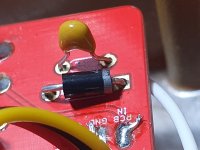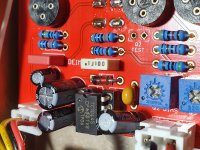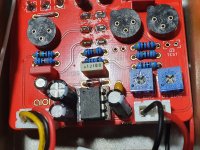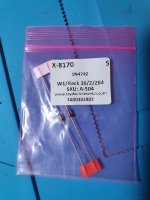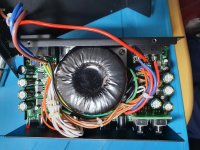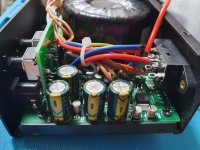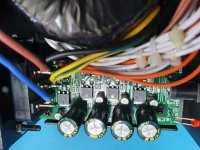DAJE
Well-known member
A couple of pedals made nasty noises and stopped working last night.
One of them (Aion Deimos, Tone Bender Mk2) did a weird thing where the LED would blink and the only sound through the amp was a ticking in time with the blinks.
The other is my Kliché Mini, which simply stopped working.
Currently they both do nothing. No sound, no LED, nada. The Deimos passes sound because it's truly bypassed, the Kliché isn't so it's a brick.
They were plugged into the same power supply, along with the rest of my pedals. Long story short, I suspected the supply might have an issue, so I tested the outputs with a battery tester and an adaptor. Most of the outputs put out a little over 9V, but one was 15V and two - I think the two that the affected pedals were plugged into - were over 20V.
So, yeah, the power block outputs are genuinely isolated, but 20V into my pedals is a very bad thing and I am very annoyed that I didn't think to test this before. There are DIP switches, but they were all set to 9V, and I switched them and retested and they still put out way too much voltage. It's a Mosky C8, a clone of a Voodoo Lab PP2+.
OK, thanks; I do not want or need a lecture about how I shouldn't have bought a relatively cheap power supply. If that's your only contribution, save yourself the effort. I bought it a while ago, didn't start using it until fairly recently, I have no chance of getting a refund, it's going into the e-waste pile, let's all move on with our lives now.
The rest of my pedals are fine.
I tried batteries and I tried a known good 9V power supply. No result.
I swapped out the charge pump in the Deimos with one from a working pedal: no change. The diodes look fine, no sign of them having blown up or burnt out. No magic smoke release that I can see or smell. Everything looks OK.
Deimos schematic attached.
Anyway, getting to the question - what should I check? And, given that I do not have an audio probe, and may or may not have the parts to build one, how do I check? I can check continuity with my MM, and voltages, beyond that I am unsure. Any informed guesses as to how much is likely to be in need of replacement?
EDIT: The electrolytics in the Deimos are all rated at 35V, the ones in the Kliché Mini are a mix of 35V and 50V. They all look fine, no sign of any damage that I can see.
One of them (Aion Deimos, Tone Bender Mk2) did a weird thing where the LED would blink and the only sound through the amp was a ticking in time with the blinks.
The other is my Kliché Mini, which simply stopped working.
Currently they both do nothing. No sound, no LED, nada. The Deimos passes sound because it's truly bypassed, the Kliché isn't so it's a brick.
They were plugged into the same power supply, along with the rest of my pedals. Long story short, I suspected the supply might have an issue, so I tested the outputs with a battery tester and an adaptor. Most of the outputs put out a little over 9V, but one was 15V and two - I think the two that the affected pedals were plugged into - were over 20V.
So, yeah, the power block outputs are genuinely isolated, but 20V into my pedals is a very bad thing and I am very annoyed that I didn't think to test this before. There are DIP switches, but they were all set to 9V, and I switched them and retested and they still put out way too much voltage. It's a Mosky C8, a clone of a Voodoo Lab PP2+.
OK, thanks; I do not want or need a lecture about how I shouldn't have bought a relatively cheap power supply. If that's your only contribution, save yourself the effort. I bought it a while ago, didn't start using it until fairly recently, I have no chance of getting a refund, it's going into the e-waste pile, let's all move on with our lives now.
The rest of my pedals are fine.
I tried batteries and I tried a known good 9V power supply. No result.
I swapped out the charge pump in the Deimos with one from a working pedal: no change. The diodes look fine, no sign of them having blown up or burnt out. No magic smoke release that I can see or smell. Everything looks OK.
Deimos schematic attached.
Anyway, getting to the question - what should I check? And, given that I do not have an audio probe, and may or may not have the parts to build one, how do I check? I can check continuity with my MM, and voltages, beyond that I am unsure. Any informed guesses as to how much is likely to be in need of replacement?
EDIT: The electrolytics in the Deimos are all rated at 35V, the ones in the Kliché Mini are a mix of 35V and 50V. They all look fine, no sign of any damage that I can see.
Attachments
Last edited:


